- Home
- Elizabeth George
This Body of Death Page 19
This Body of Death Read online
Page 19
It’s interesting to note that when the boys leave the Barriers, they do not do so by the exit that would take them to the Gallows, i.e., by the exit most familiar to them. Instead, they choose one of the lesser-used exits, as if they already have planned to do something with the toddler and wish to remain as unseen as possible when they make off with him.
In his third interview with the police, Ian Barker claims that their intention was just to “have a bit of fun” with John Dresser, while Michael Spargo says that he didn’t know “what them other two wanted with that baby,” a term (“the baby”) that Michael uses throughout his conversations with the police in reference to John Dresser. For his part, Reggie Arnold will not come close to discussing John Dresser until his fourth interview. Instead, he attempts to obfuscate, making repeated references to Ian Barker and his own confusion about “what he wanted that kitten for,” attempting to direct the course of the conversation on to his siblings, or assuring his mother—who was present for nearly all interviews—that he “didn’t nick nothing, never ever, Mum.”
Michael Spargo claims that he wanted to return the toddler to the shopping arcade once they had him outside the Barriers. “I told them we could drop him back inside, just leave the baby by the door or something, but they were the ones didn’t want to. I said we’d get into trouble for nicking him, wouldn’t we [note the objectifying use of nicking, as if John Dresser were something they’d pinched from a shop] but they called me a wanker and asked me did I want to grass them up, then.”
Whether this actually happened remains open to doubt as neither of the other two boys refers to Michael having second thoughts. And later nearly every witness—who came to be known collectively as the Twenty-Five—confirms that their sightings of the boys involved all three of them and John Dresser, and all three of them seemed to be actively involved with the little boy.
Considering his past, it seems reasonable to conclude that Ian Barker was the one to suggest they see what would happen if they swung John Dresser as they had been doing but dropped him instead of landing him safely on his feet. This they did, releasing him at the apex of the swing and projecting him ahead of them at some speed, with the apparent and expected effect of John’s beginning to cry when he hit the pavement. This fall caused the first of the bruises to John’s bottom and, possibly, the first of the ultimately extensive damage done to his clothing.
With a clearly distressed toddler on their hands, the boys made their first attempt to settle him down by offering him the jam roll that Michael Spargo had taken from his home that morning. That John accepted it is clear not only from the extensive report of Dr. Miles Neff of the Home Office, but also from witness evidence, for it was at this point that the boys had their first encounter with someone who not only saw them with John Dresser but who also stopped to question them about him.
Trial transcripts show that when seventy-year-old Witness A (all witness names will be withheld from this document for their own protection) saw the boys, John was upset enough to concern her:
“I asked them what was wrong with that baby,” she says, “and one of them—I think it was the fat one [a reference to Reggie Arnold]—told me he’d fallen and banged his bum. Well, children do fall, don’t they? I didn’t think…I did offer to help. I offered them my handkerchief for his face ’cause he was crying so. But then the taller boy [referring to Ian Barker] said it was his baby brother and they were taking him home. I asked them how far they had to go and they said not far. Just over in Tideburn, they said. Well, as the baby began eating a jam roll they offered him, I couldn’t see there would be further trouble.”
She goes on to say that she asked the boys why they weren’t at school, and they told her school was finished for the day. This apparently mollified Witness A, who told them to “get the baby home then” because “he’s obviously wanting his mum.”
She doubtless was additionally mollified by the boys’ inspired use of Tideburn as their putative habitation. Tideburn was then and is now safely middle class to upper middle class. Had they said the Gallows—with all that saying the Gallows implied—her concerns might have been triggered.
Much has been made of the fact that the boys could have turned John Dresser over to Witness A at that moment, saying they’d found him wandering outside the Barriers. Indeed, much has been said of the fact that the boys had repeated moments when they could have handed John Dresser to an adult and gone on their way. That they didn’t suggests that somewhere along the line at least one of them was working on a larger plan. Either that or a larger plan had been earlier discussed among the three of them. But if this latter is the case, it is also something that not one of the boys has ever been willing to reveal.
The police were phoned once the CCTV tapes had been viewed by the Barriers’ head of security. By the time they arrived to look at the tapes themselves and to mount a search, however, John Dresser was approximately one mile away. In the company of Ian Barker, Michael Spargo, and Reggie Arnold, he had crossed two heavily trafficked roadways and he was both tired and hungry. He had fallen several more times, apparently, and had cut his cheek on a raised piece of the pavement.
It was becoming trying to be in his company, but still the boys did not release John Dresser to anyone. According to Michael Spargo’s fourth interview, it was Ian Barker who first kicked the toddler when he fell and it was Reggie Arnold who hauled the little boy back on his feet and began to drag him. John Dresser was apparently quite hysterical at this point, but this appears to have caused passersby to believe more firmly in the tale told by the boys that they were attempting to take “my little brother” home. Whose little brother John Dresser supposedly was was a detail that became a shifting target, dependent solely upon the speakers (Witnesses B, C, and D), and while Michael Spargo denies in every interview that he ever claimed John Dresser as a sibling, this assertion is contradicted by Witness E, a postal worker who encountered the boys midway to the Dawkins building site.
Witness E’s testimony has him asking the boys what’s wrong with the toddler, why’s he crying so, and what’s happened to his face?
“He said—this was the one in the yellow anorak, mind—that it was his brother and that Mum was doing the business with her boyfriend at the house and they were meant to keep the little ’un busy till she was finished. They said they’d walked a bit too far and could I drive them home in my van?”
This was, if anything, an inspired request. Surely the boys knew that Witness E would not be able to accommodate them. He was on his route, and even if that had not been the case, there was probably inadequate room within his vehicle. But the fact that this request had been made gave legitimacy to their story. Witness E reports that he “told them to take the tyke directly home, then, ’cause he was blubbing like nothing I ever seen and I got three of my own,” and the boys agreed to do this.
It appears possible that their intentions towards John Dresser, while inchoate when they first snatched him, began to develop with the consecutive string of successful lies they were able to tell about him, as if the easy belief of the witnesses whetted the boys’ appetite for abuse. Suffice it to say that they continued on their way, managing to walk the toddler more than two miles despite his protests and his cries of “Mummy” and “Da,” which were heard, and ignored, by more than one person.
Michael Spargo claims that during this period he asked again and again what they were going to do with John Dresser. “I told them we couldn’t take him home with us. I told them. I did,” the transcript of his fifth interview has him declaring. He also declares that it was at this point that he brought up the idea of leaving John at a police station. “I said we could leave him on the steps or something. We could leave him inside the door. I said his mum and dad’re going to be worried. They’re going to think something’s happened to him.”
Ian Barker, Michael says, declared that something had happened to the toddler. “He said, ‘Stupid git, something did happen.’ And he asked Reg did he thin
k the baby’d make a splat when he hit the water.”
Was Ian considering the canal at that point? Possibly. But the fact of the matter was that the boys were nowhere near the Midlands Trans-Country Canal and they were not going to be able to get an exhausted John Dresser there unless they carried him, which they apparently did not wish to do. But had Ian Barker been harbouring a desire to inflict some sort of injury upon John Dresser in the environs of the canal, he had now been thwarted and John himself was the reason why.
John Dresser’s company becoming progressively more difficult, the boys made the decision to “lose the baby in a supermarket somewheres” according to Michael Spargo, because the entire affair had become “dead boring, innit.” There was no supermarket in the immediate vicinity, however, and the boys set out to find one. It was on their way that Ian, as Michael and Reggie report in separate interviews with the police, pointed out that in a shop they might be seen and even documented on CCTV. He indicated he knew of a much safer location. He led them to the Dawkins building site.
The site itself was a grand idea gone bad through loss of funding. Originally intended as three stylishly modern office blocks within “a lovely, parklike setting of trees, gardens, paths, and copious outdoor seating,” it had been intended to infuse money into the surrounding community in order to bolster a faltering economy. But poor management on the part of the contractor resulted in the project being called to a halt before the first tower was completed.
On the day that Ian Barker ushered his companions to the site, it had languished untouched for nineteen months. It was fenced by chain link, but it was not inaccessible. Although signage on the fence warned that the site was “under surveillance 24 hours a day” and that “trespassers and vandals will be prosecuted to the fullest extent of the law,” regular incursions into the property made by children and adolescents indicated otherwise.
It was a tempting area both for playing and for clandestine rendezvous. There were dozens of places to hide; heaps of earth offered launching pads for mountain bikers; discarded boards, tubes, and pipes could stand in for weapons in games of war; small chunks of concrete substituted nicely for hand grenades and bombs. While it was a dubious location in which “to lose the baby” if the boys intended someone to come across him and take him to the nearest police station, it was a perfect spot in which the rest of the day’s horrors could play out.
Chapter Ten
WHEN THOMAS LYNLEY PULLED UP TO THE KIOSK AT NEW Scotland Yard the next morning, he began the process of steeling himself. The constable in charge stepped forward, not recognising the car. When he saw Lynley inside it, he hesitated before bending to the lowered window and saying huskily, “Inspector. Sir. It’s very good to have you back.”
Lynley wanted to say that he wasn’t back. But instead he nodded. He understood then what he should have understood before: that people were going to react to his appearance at the Yard and that he was going to have to react to their reacting. So he readied himself for his next encounter. He parked and went up to a set of offices in Victoria Block as familiar to him as his own home.
Dorothea Harriman saw him first. It had been five months since he’d encountered the departmental secretary, but neither time nor circumstances were ever likely to alter her. She was, as always, kitted out to perfection, today in a red pencil skirt and breezy blouse, a wide belt cinching in a waist that would have made a Victorian gentleman swoon. She was standing at a filing cabinet with her back to him, and when she turned and saw him, her eyes filled and she set a file on her desk and clasped both her hands at her throat.
She said, “Oh, Detective Inspector Lynley. Oh my God, how wonderful. It couldn’t possibly be better to see you.”
Lynley didn’t think he could live through more than one greeting such as this, so he said, as if he’d never been gone, “Dee. You look well today. Are they … ?” and he indicated with a nod towards the superintendent’s office.
She told him that they were gathered in the incident room and did he want a coffee? Tea? A croissant? Toast? They’d recently started offering muffins in the canteen and it was no trouble—
He was fine, he told her. He’d had breakfast. She wasn’t to bother. He managed a smile and set off for the incident room, but he could feel her eyes on him and he knew he was going to have to get used to people assessing him, considering what they should say or not say, unsure how soon or even whether to mention her name. It was, he knew, the way of all people as they navigated the waters of someone else’s grief.
In the incident room, it was much the same. When he opened the door and walked in, the stunned silence that fell upon the group told him that Acting Superintendent Ardery hadn’t mentioned he’d be joining them. She was standing to one side of a set of china boards on which photos were posted and officers’ actions were listed. She saw him and said casually, “Ah, Thomas. Good morning,” and then to the others, “I’ve asked Inspector Lynley to come back on board and I hope his return is going to be a permanent one. Meanwhile, he’s kindly agreed to help me learn the ropes round here. I trust no one has a problem with that?” The way she spoke sent the message clearly: Lynley was going to be her subordinate and if anyone did have a problem with that, that relevant anyone could request reassignment.
Lynley’s gaze took them in, his longtime colleagues, his longtime friends. They welcomed him in their various ways: Winston Nkata with blazing warmth on his dark features, Philip Hale with a wink and a smile, John Stewart with the guarded expectancy of one who knows there’s more here than meets the eye, and Barbara Havers with confusion. Her face showed the question that he knew she wanted to ask him: Why didn’t you tell me yesterday? He didn’t know how he could explain. Of everyone at the Yard, she was closest to him and thus she was the last person to whom he could comfortably speak. She wouldn’t understand this, and he didn’t yet possess the words to tell her.
Isabelle Ardery continued the meeting that they had been having. Lynley took out his reading glasses and worked his way closer to the china board upon which the victim’s photographs were displayed, in life and in death, including grisly autopsy photos. An e-fit of a person of interest was situated near the pictures of the murder site, and next to this was a close-up of what appeared to be some sort of carved stone. This was an enlargement: The stone was reddish and square and it had the look of an amulet.
“…in the victim’s pocket,” Ardery was saying in apparent reference to this photograph. “It looks like something from a man’s ring, considering the size and the shape of it, and you can see it’s been carved although the carving itself is quite worn. It’s with forensics just now. As to the weapon, SO7 are telling us the wound suggests something capable of piercing to a depth of eight or nine inches. That’s all they know. There was rust left in the wound as well.”
“Plenty of that on the site,” Winston Nkata pointed out. “Old chapel, locked off with iron bars …Has to be a mountain of clobber round that place could be used for a weapon.”
“Which takes us to the possibility that this was a crime of opportunity,” Ardery said.
“No handbag with her,” Philip Hale said. “No identification on her. And she’d’ve had to have something to get up to Stoke Newington. Money, travel card, something. Could’ve started with bag snatching.”
“Indeed …So we need to put our hands on that bag of hers, if she had one,” Ardery said. “In the meantime, we’ve got two very good leads from the porn magazine left near the body.”
Called Girlicious, it was the type of magazine that was delivered to the point of sale encased in opaque black plastic, due to the sensitive—and here Ardery rolled her eyes—nature of its contents. This plastic served the purpose of preventing innocent children from pawing through it to have a look at the various pudenda on display. It also served the less obvious purpose of preventing the fingerprints of anyone other than the purchaser to be placed upon it. Now, they had a very good set of dabs to use in the investigation, but better than that, t
hey had a shop receipt tucked within the pages, as if used as a marker. If this shop receipt was the point of purchase of the magazine—and it likely was—then there was a very good chance they were on the trail of whatever sod had bought it.
“He might or might not be our killer. He might or might not be this person—” She indicated the e-fit. “But the magazine was fresh. It hadn’t been there long. And we want to talk to whoever took it into that chapel’s annex. So …”
She began the assignments. They knew the drill: TIE first. The known associates of Jemima Hastings had to be interviewed: at Covent Garden where she was employed, at her lodgings in Putney, at any other place she frequented, at the Portrait Gallery where she had been present for the opening of the exhibition in which her picture hung. All of them would need alibis that would want checking out. Her belongings had to be gone through as well, and there were boxes upon boxes of them from her lodgings. An ever-widening search of the area near the cemetery had to be made to attempt to locate her bag, the weapon, or anything related to her journey across London to Stoke Newington.
Ardery finished making the assignments. She concluded these with the fact that Detective Sergeant Havers would track down a woman called Yolanda the Psychic.
“Yolanda the what?” was Havers’ response.
Ardery ignored her. They’d had a phone call from Bella McHaggis, she said, Jemima Hastings’ landlady in Putney. A Yolanda the Psychic needed to be looked into. It seemed she’d been stalking Jemima—“Bella’s word, not mine”—so they needed to find her and give her a grilling. “I trust you have no difficulty with that, Sergeant?”

 Well-Schooled in Murder
Well-Schooled in Murder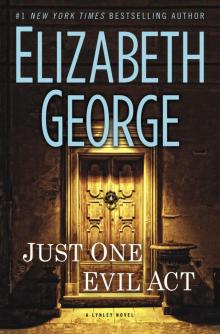 Just One Evil Act
Just One Evil Act This Body of Death
This Body of Death The Edge of the Water
The Edge of the Water For the Sake of Elena
For the Sake of Elena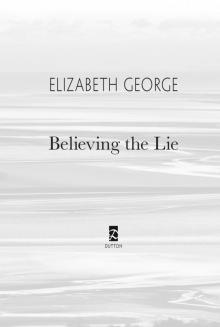 Believing the Lie
Believing the Lie The Edge of the Shadows
The Edge of the Shadows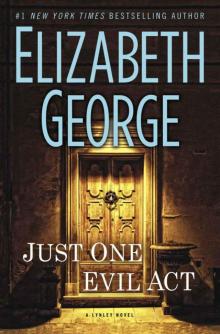 Just One Evil Act: A Lynley Novel
Just One Evil Act: A Lynley Novel In Pursuit of the Proper Sinner
In Pursuit of the Proper Sinner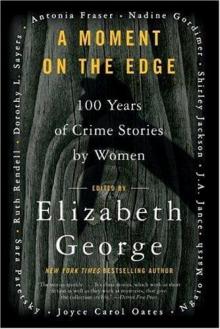 A Moment on the Edge:100 Years of Crime Stories by women
A Moment on the Edge:100 Years of Crime Stories by women Elizabeth I
Elizabeth I I, Richard
I, Richard A Traitor to Memory
A Traitor to Memory Missing Joseph
Missing Joseph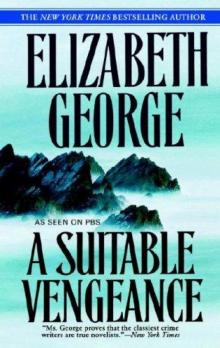 A Suitable Vengeance
A Suitable Vengeance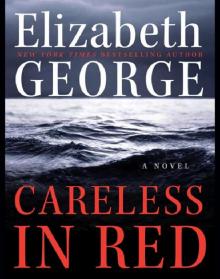 Careless in Red
Careless in Red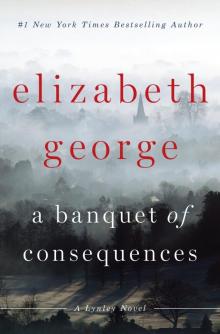 A Banquet of Consequences
A Banquet of Consequences Playing for the Ashes
Playing for the Ashes With No One As Witness
With No One As Witness Deception on His Mind
Deception on His Mind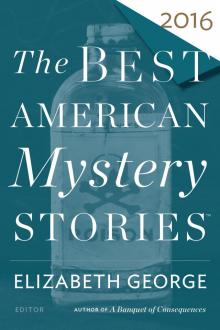 The Best American Mystery Stories 2016
The Best American Mystery Stories 2016 A Great Deliverance
A Great Deliverance In the Presence of the Enemy
In the Presence of the Enemy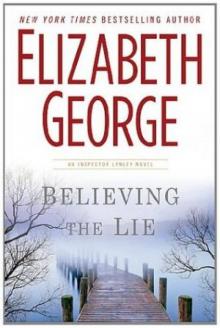 Believing the Lie il-17
Believing the Lie il-17 The Edge of the Light
The Edge of the Light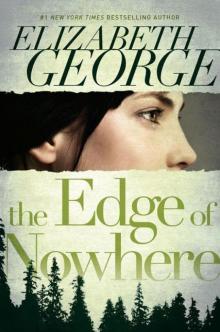 SW01 - The Edge of Nowhere
SW01 - The Edge of Nowhere A Place of Hiding
A Place of Hiding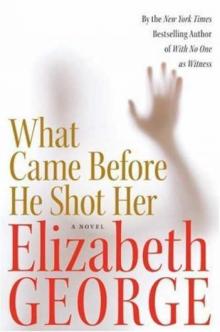 What Came Before He Shot Her il-14
What Came Before He Shot Her il-14 Payment In Blood
Payment In Blood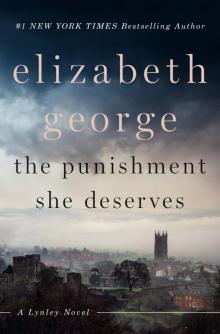 The Punishment She Deserves
The Punishment She Deserves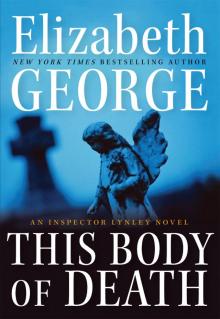 This Body of Death: An Inspector Lynley Novel
This Body of Death: An Inspector Lynley Novel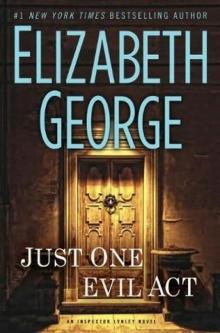 Just One Evil Act il-18
Just One Evil Act il-18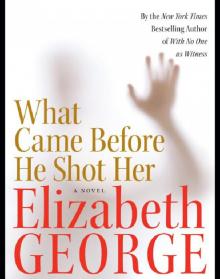 What Came Before He Shot Her
What Came Before He Shot Her Missing Joseph il-6
Missing Joseph il-6